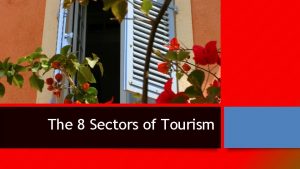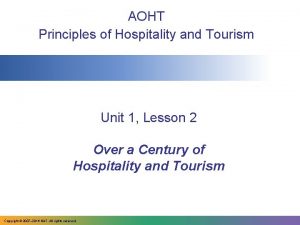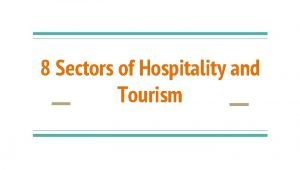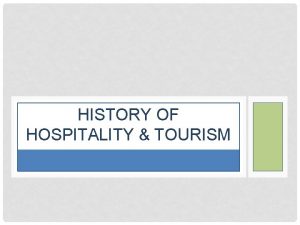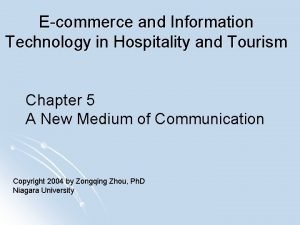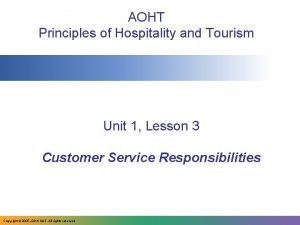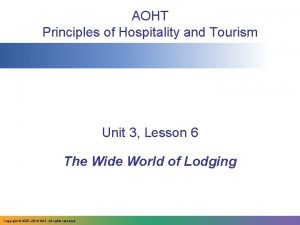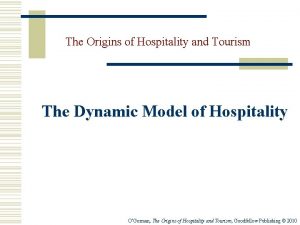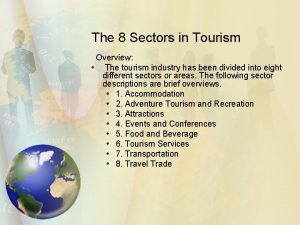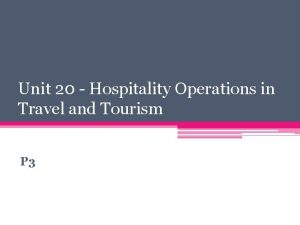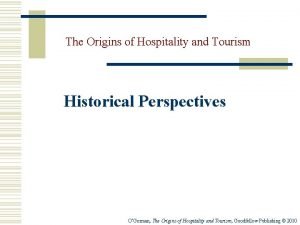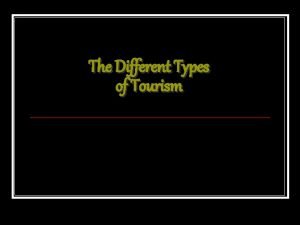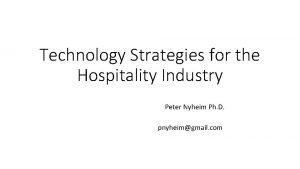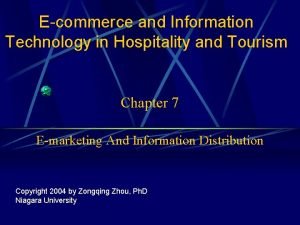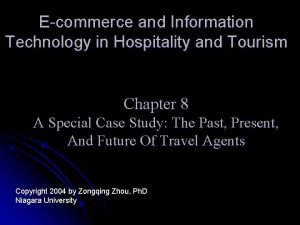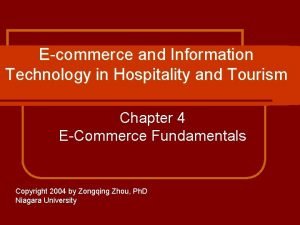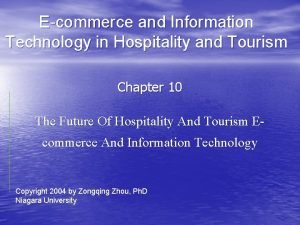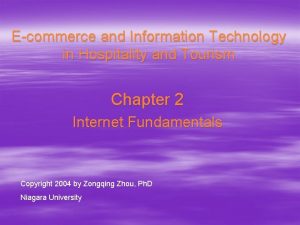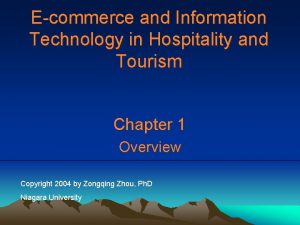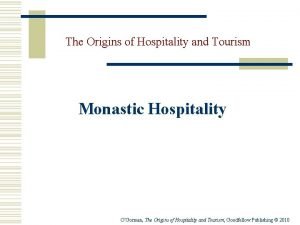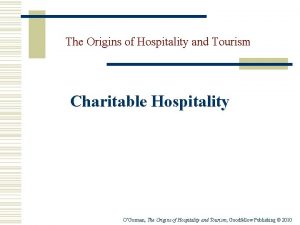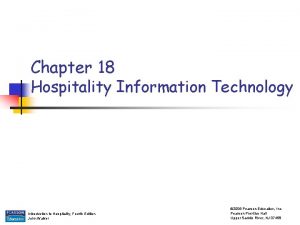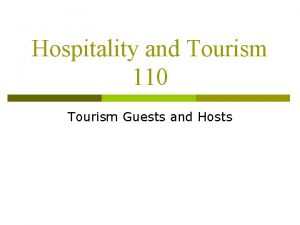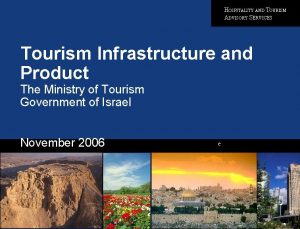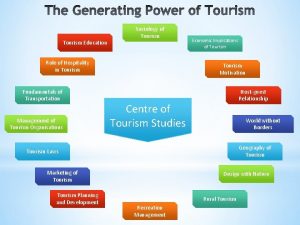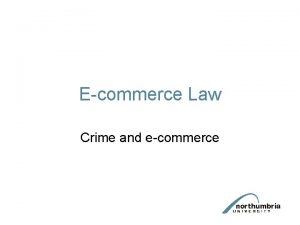Ecommerce and Information Technology in Hospitality and Tourism


























- Slides: 26

E-commerce and Information Technology in Hospitality and Tourism Chapter 3 Connecting to the World Copyright 2004 by Zongqing Zhou, Ph. D Niagara University

3. 1 Establishing a Standard Connection • To connect to the Internet via telephone line you will need four basic things: • A computer • A modem • An internet Service Provider • A browser

Figure 3. 1 Analog data Digital data Modulator Digital transmitter Modem Analog transmission (public telephone network) Digital transmission (Digital data lines or local area network) Analog transmission (public telephone network)

Modem • Modem comes from • Modulator • Demodulator • A modem is an electronic device for converting between digital data from a computer or an audio signal suitable for transmission over telephone lines. • The speed of data transmission is measured in bits per second, kilobits per second or in bauds.

Modem (cont. ) • A modems most common speeds are • 28, 800 • 36, 000 • 56, 000 • Modems • Internal • External

ISP and OSP • The gateways • ISP (Internet Service Provider) • OSP (Online Service Provider)

ISP and OSP • ISP • Once connected you are directly connected to the Internet; it has no control over what you can access on the Internet. • Most important factors when choosing an ISP: • Local phone number • Other features − Speed − Features − Pricing − Reliability

ISP and OSP • OSP • You are connected to the Internet through OSP’s server • OSP tends to offer its own programs which are screened and filtered through your service provider.

Figure 3. 2 Computer Modem ISP Internet

3. 2 Alternative Connections • Broadband communications channels- highspeed internet access. • ISDN (Integrated Services Digital Network) • A system of digital phone connections allowing a single wire or optical fiber to carry voice, digital network services, and video. Intended to replace POTS (plain old telephone system)

3. 2 Alternative Connections • Cable modem • Most widely subscribed • Typically faster than DSL • Typically an external device

3. 2 Alternative Connections • DSL (Digital Subscriber Line) *leading method • Plugs into the existing LAN • Best available method of connection • Wireless • No physical connection • Mobility and adaptability

3. 2 Alternative Connections • Bandwidth- the amount of data that can be sent through a given communications circuit per second.

Wireless Terms • WAP (Wireless Applications Protocol)allowing device manufactures and service providers to be bale to talk to each other, so that digital content can be delivered to consumers through the air regardless of standard used. • WML (Wireless Markup Language)language used to specify content and user interface.

Wireless Terms • W-CDMA or I-Mode- allows one to view 256 color graphics and HTML on their phones. • HDML (Handheld Device Markup Language)- uses its own gateway to provide access to the wireless Web. • XML (External Markup Language)- markup symbols to describe the content of a page or file.

3. 3 Networking: LAN and WAN • LAN- local area network • A high speed data communication network that connects computers and other terminals within a geographically limited area, typically within adjacent buildings or complexes. • It is different from PANs (personal area networks) MANs (metropolitan area networks), or WANs (wide area networks). • LANs are typically faster than WANs

3. 3 Networking: LAN and WAN • Benefits of using networks • Allows sharing of resources like printers • Easy and fast information sharing • Share software • Response to service request is faster and better

3. 3 Networking: LAN and WAN • Early LANs were vendor specific and used different standards. • Today there are two common wiring technologies for a LAN, Ethernet and Token Ring.

3. 3 Networking: LAN and WAN • Wireless technologies are starting to evolve and are convenient for Mobile computer users. • When using Ethernet the computers are usually wired to a hub or to a switch. This constitutes the physical transport mechanism.

3. 3 Networking: LAN and WAN • LANs can be interlinked by connections to form a Wide area network. A router is used to make the connection between LANs.

3. 3 Networking: LAN and WAN • WAN- wide area network • Typically the same as a LAN but covers more geographical area.

LAN Terms • Firewall- is a set of related software programs that protect the resources of a LAN or a private network from users from other networks. • Four main LAN systems: • Ethernet • Token Ring • Arcnet System • FDDI

Figure 3. 3 Computer LAN Internet Computer Internet Firewall Computer Location of a firewall, which guards against unauthorized access to a LAN or Internet.

Figure 3. 4 Server Computer Bus Computer A bus-typology Ethernet LAN

Figure 3. 5 Computer Ring Computer Server A token ring LAN

Figure 3. 6 File server Workstation Wired Ethernet LAN Workstation Antenna Access point 2 Access point 1 A wireless LAN with two access points.
 Tourism information technology
Tourism information technology Tourism the business of hospitality and travel
Tourism the business of hospitality and travel Different sectors of tourism industry
Different sectors of tourism industry Marketing for hospitality and tourism 7th edition
Marketing for hospitality and tourism 7th edition Tourism the business of hospitality and travel 5th edition
Tourism the business of hospitality and travel 5th edition Hospitality and tourism final exam
Hospitality and tourism final exam Internal marketing in tourism
Internal marketing in tourism Marketing for hospitality and tourism notes
Marketing for hospitality and tourism notes Contemporary issues in tourism
Contemporary issues in tourism Aoht principles of hospitality and tourism
Aoht principles of hospitality and tourism Eight sectors of the tourism industry
Eight sectors of the tourism industry The interrelated nature of hospitality, travel and tourism
The interrelated nature of hospitality, travel and tourism History of hospitality and tourism industry
History of hospitality and tourism industry E commerce tools in tourism and hospitality
E commerce tools in tourism and hospitality Aoht principles of hospitality and tourism
Aoht principles of hospitality and tourism Tourism industry definition
Tourism industry definition New money spent by tourists and then respent by hotels
New money spent by tourists and then respent by hotels Aoht principles of hospitality and tourism
Aoht principles of hospitality and tourism The origins of hospitality and tourism
The origins of hospitality and tourism The origins of hospitality and tourism
The origins of hospitality and tourism 8 sectors of tourism industry
8 sectors of tourism industry Unit 20 hospitality operations in travel and tourism
Unit 20 hospitality operations in travel and tourism Pineapple tradition
Pineapple tradition The origins of hospitality and tourism
The origins of hospitality and tourism Introduction to hospitality marketing
Introduction to hospitality marketing Mass tourism vs alternative tourism
Mass tourism vs alternative tourism Technology strategies for the hospitality industry
Technology strategies for the hospitality industry


